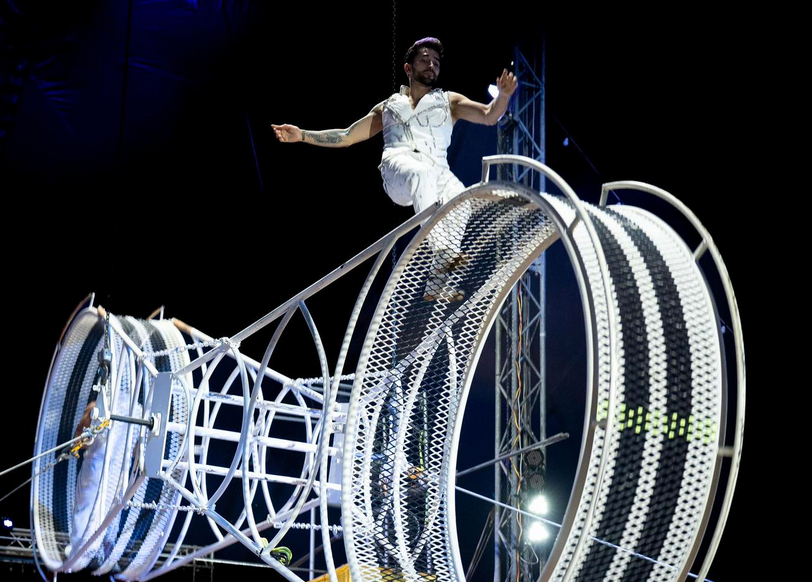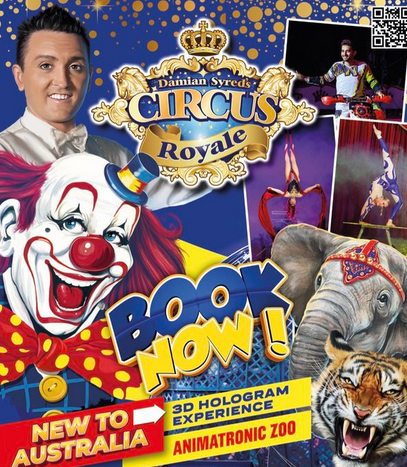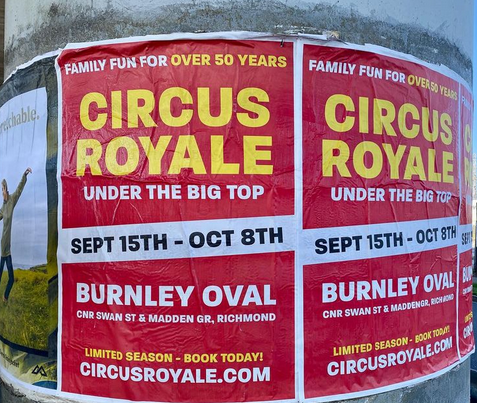
In Defence of the Traditional Circus

In mid-September, my eleven-year-old god-daughter and I went to a matinee show of the circus at Burnley Oval, on Swan Street in Richmond. Its name was Circus Royale, but for a little while, seeing the advertising without really reading it, I’d thought it was Silver’s Circus. Silver’s seems to pop up more often in Melbourne, and the aesthetics of traditional circuses are very much of a type.
And I have to say that initially, Circus Royale suffered in comparison with Silver’s. It began with the “animatronic zoo” in the atrium outside the big top. Although I’m one of those people who likes weird stuff, this sad rabble of robotic tigers and zebras and so on gave me the heebie jeebies, and not in a good way. If they were a replacement for the animals that were once forced to perform in circuses—I’m arguing in favour of tradition, but this is one change I agree with—it was a poor one. But you could rest assured that they posed no threat to the outside world, which wasn’t always true of real circus animals. I discovered this years ago, when I met some old showmen in a travelling circus. They told me about a time one of their lions escaped in regional Victoria. Late in the day, they said, the police came to tell them the lion had been recaptured—but when they went to see it, it was someone else’s lion. No danger of losing these sad clunky robots.
Then there was the big top itself, which also wasn’t impressive at first. There was too much daylight. It was windy outside, and the day was blowing in under the tent’s skirts; the real world was getting in, which mustn’t be allowed to happen. The big top is necessarily its own separate universe. It’s like jianghu, the abstract place in Chinese culture where romances and kung fu epics take place, and the worries of everyday life are forgotten.
This big top didn’t feel like a Western version of jianghu. It felt as if it was on Burnley Oval, on Swan Street in Richmond.
But in fairness, I should add that there was a distraction particular to my experience, namely my god-daughter, who’d been convinced, I think by overexposure to YouTube, that she was terrified of clowns. This  meant that even before the show’s single, quite inoffensive clown made an appearance, we had to go outside to depressurise for a bit.
meant that even before the show’s single, quite inoffensive clown made an appearance, we had to go outside to depressurise for a bit.
When we re-entered a few minutes later, the acrobats were in full swing. We were captivated at once. The other world had taken hold. We were in jianghu.
In the absence of lion trainers and horse trick-riders, we were treated to the Space Wheel, the Sphere of Death, the High Wire and other acrobatic acts, with the performers executing stunts that required immense skill, strength and precision.
It was a busy program, less of a spectacle than Silver’s. The acrobats were the focus. They were carnie gods and goddesses under the celestial downlights. They were flawless, iconic, like the figures in Tarot.
Circus is an inversion of the usual order, but it has its own rigorous form, and the roles in the show were strictly gendered—the aerial silks, for instance, were performed by a woman. And generally the women’s performances were more dancerly (if that’s a word) than the men’s, whose acts were shows of power and courage.
We had met three or four of these shortish but chasteningly muscular men before the show, when they were doubling as ushers (everyone has to pitch in). If there’s ever a competition for geometric shapes occurring in nature, these glowering men would be sure to do well in the Torsos That Look Like Inverted Equilateral Triangles category.
They didn’t seem all that happy to be showing us to our seats, but I felt they were justified in their bulletproof arrogance. On meeting them, I tried to console myself that I’m an intellectual and they probably aren’t; but I also remembered that Plato (a paradigmatic intellectual) was also heavily muscled, that his name was actually a nickname given to him by his wrestling coach, reflecting the broadness of his body … “It is a shame for a man to grow old,” he wrote, “without seeing the beauty and strength of which his body is capable.”
Blithely, these platonic figures strutted and stalked, strode and vaulted metres above the ring—and when their acts were done and they returned to Earth, their bows and other gestures were perfectly formed, pure expressions of showmanship. It was impossible not to applaud.
A few days later, I met Damian Syred, the ringmaster and owner. Confident and fresh-faced with short blond hair, he was young for someone with his responsibilities (he’s advertised as Australia’s youngest circus owner), and he was generous with his time even though he was a busy man, fielding questions from staff and checking two mobile phones while we talked.
He told me a little of his history. It was an extraordinary story.
He first saw Circus Royale when he was six years old, in his home town in Western Australia. He saw it again when he was twelve, and then again when he was fourteen—at which point he approached the owners to declare that he would buy the circus some day. “I was an ambitious teenager!” he said. “But it was very unlikely that it would happen. Circuses are like heirlooms, passed down through the generations …”
But the unlikely happened. The sons of the owners moved on to other careers, and the family wanted to divest itself, and one night he got a call to ask if he was still interested. In 2007 the circus became his. It was the realisation of a childhood dream. I’ve met a few people like this: successful people who have followed a single path their entire lives.
The conversation moved on to a discussion of some of the memorable audience members he’d encountered over the years. He told me about a woman who’d approached him after a show, wanting to know about the people who worked there: “She asked what we eat. She was surprised that we eat the usual things. She asked if we go on dates, if we can get married and have kids. She asked if the women have periods.”
All of which is bizarre, but I understand the woman’s confusion. Circus people are their own distinct class. They’re not working-class or middle-class, but something other. They’re unattached to society. They can travel everywhere without changing their acts, because they’re universal. They’re magical, as circus is.
Damian might have looked at me oddly when I brought this up, but I stand by it. There are some magical things in life. The novella The Nutcracker and the Mouse King by E.T.A. Hoffmann. Mervyn Peake’s novel Titus Groan. Liszt’s Hungarian Rhapsody No. 2. For me, it’s impossible to imagine how these marvellous things came about. They might as well have come from nowhere, from nothing, and magic can be defined as getting something from nothing.
By contrast, circuses like Cirque du Soleil don’t get something from nothing. They get lavish government  funding, not only in their native Canada, but also in Melbourne. “We don’t have the same sort of recognition here,” Damian said. “The council is very difficult about us visiting. We’re not recognised as an art form. But when Cirque du Soleil come, they let them rip the ground up; they let them do whatever they want to do … I think shows like that are great entertainment, but they don’t want to acknowledge where circus came from.”
funding, not only in their native Canada, but also in Melbourne. “We don’t have the same sort of recognition here,” Damian said. “The council is very difficult about us visiting. We’re not recognised as an art form. But when Cirque du Soleil come, they let them rip the ground up; they let them do whatever they want to do … I think shows like that are great entertainment, but they don’t want to acknowledge where circus came from.”
Where circus came from. In its classical, Roman form, with the animals in the ring, the city containing nature, rather than the reverse, circus represented the triumph of the unnatural over the natural.
While twee, relentlessly tasteful shows like Cirque du Soleil replace the circus-soul with sanitised spectacle, traditional circus is, properly, otherworldly. It’s a continuation of ancient traditions.
For instance, the Gasser family, the original owners of Circus Royale, were Swiss immigrants who’d been in the industry since 1437. Damian told me about Switzerland. It’s traditionally clean and sensible, but it gets circus. “The whole country is smaller than Victoria, and they have seventeen circuses,” he said.
With all that said, he’s not bitter. He loves his job. He lit up when he talked about the kids in his audiences, and about visiting country towns. “The children had never seen a circus … The way they held their tickets, saying they’re going to keep them forever. They said it was the best thing they’d ever seen.” The kids won’t have this experience if travelling shows like this one are allowed to disappear.
It’s inevitable that there are going to be dodgy elements to it, like the animatronic zoo. That’s part of the deal. Traditional circus is dirty. It’s alchemical. The ring is a window into the underworld, and its characters are printed straight from the archetypewriter. It’s living history—it’s the only place where Baroque ornament hasn’t died out—it’s a form of cultural nourishment, and an essential piece of our collective wellbeing that is rapidly being eroded from the landscape. For the health of our culture, it deserves our support.
Adam Browne lives in Melbourne. He is the author of three science-fiction books and numerous short stories
Madam: Archbishop Fisher (July-August 2024) does not resist the attacks on his church by the political, social or scientific atheists and those who insist on not being told what to do.
Aug 29 2024
6 mins
To claim Aborigines have the world's oldest continuous culture is to misunderstand the meaning of culture, which continuously changes over time and location. For a culture not to change over time would be a reproach and certainly not a cause for celebration, for it would indicate that there had been no capacity to adapt. Clearly this has not been the case
Aug 20 2024
23 mins
A friend and longtime supporter of Quadrant, Clive James sent us a poem in 2010, which we published in our December issue. Like the Taronga Park Aquarium he recalls in its 'mocked-up sandstone cave' it's not to be forgotten
Aug 16 2024
2 mins







